Ignition
“The problem of problems.” Karl Benz 1880
At the dawn of internal
combustion motors many strange and unusual devices were invented to provide the
ignition needed to make the motors work.
Lenoir, the original inventor
of stationary gas motors way back in 1860 used the first spark plug fired by a
battery buzzer coil device. Otto used a tiny trap door with a
chamber for a bit of burning coal gas to slide over a hole in the top of the
combustion chamber but found that it was a poor idea.. Karl Benz
used a variation of the battery vibrator ignition on the first auto and was so
frustrated with the problems of reliability that he provided the quote about
ignition in the subtitle above..
Then a magnetic oscillating
magneto device using an upgraded primitive spark plug was used.. (the
great scientist Siemens of Germany invented the swinging twin T magneto)
Daimler’s group came up with the strange idea of a heated ceramic tube opening
into the combustion chamber. This worked well at the time and started easily.
But the external fires needed to keep the tubes hot were a dangerous
design.
Both Count Zeppelin (who
wanted to use Daimler motors in his hydrogen airships) and Emil Jellinek
(Daimlers first and best salesman, racing enthusiast, and father of Mercedes
Jellinek whom the Mercedes auto is named after) insisted that magneto ignition
be used.
Zeppelin because of the fire
hazard with the hydrogen in the airships and Jellinek because he had
experienced so many serious fires in his Daimlers when he was racing..
Robert Bosch enters at this
point as the maker of most of the oscillating magneto low voltage ignition
systems used.. Then one of Bosch’s employees came up with the high
voltage rotary magneto and that became the standard.
Daimler always resented Bosch
and was angry that his beloved hot tube ignition was discarded so quickly.
But.. There is
always a but. The magneto ignition worked well at high speeds when
the motor was running but it was very difficult to start. Since the
magnets of the day were weak and lost their magnetism slowly and the amount of
spark was directly dependent on crankshaft speed hand crank starting a magneto
motor was difficult at best and almost impossible in the cold or wet..
The early racing cars carried
a mechanic to adjust timing and mixture and operate the fuel pump while the
race was going on. But a big reason for the extra man was the “Run and
Bump” starting used. The driver and mechanic would run along beside
the car pushing it as fast as possible. Then they would jump in and the
driver would put the car in gear and let out the clutch spinning the motor fast
enough to get the magneto working.
The vibrator shower of sparks
battery ignition (which had been around for many years) on the other hand was
easy to start but very poor at higher rpm’s. (in those days 1800 rpm was
considered high) As a result many manufacturers began to use both
battery igniton for starting and then switch to magneto ignition for
running.. Complicated, expensive, and the dry cell batteries had to
be replaced often. The magnetos needed recharging of their magnets
periodically as well.
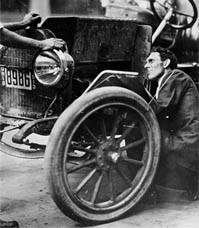
Then in about 1906 one of the
greatest inventors in history began working on an improved battery
ignition. Charles Franklin Kettering working with his small group in a
converted barn in Ohio invented the standard ignition system used from 1909 to
the present.. The Kettering ignition.
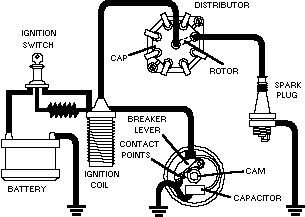
This ignition provided a
single spark at the right moment and had the precision and reliability needed
to make automobiles more than a toy or curiosity.
This is how the Kettering
system works.
The electrical current from
the battery first goes through a resistor to limit current when the points are
closed and the motor is not running and to provide a better shape to the pulse
of electricity generated by the coil. The resistor is bypassed when using
the electric starter because the voltage drop from the high current used by the
starter reduces the spark. Then the current goes through the primary
winding of the coil. This is the low voltage high current side of the
coil windings.
Then it reaches the
points. They are tungsten switch contacts inside the distributor opened
by a cam which rotates at half the speed of the crankshaft. The
points are normally closed allowing current to flow to the coil primary
winding. This period when the points are closed is called the dwell
time.
When the points open from the
passing bump on the cam the magnetic field within the coil collapses very
quickly generating a high voltage pulse in the secondary winding of the
coil. There is a serious problem with the points arcing when they open
and a capacitor (used to be called condensor) is in parallel with them to
absorb the voltage spike that would cause them to arc and burn out quickly.
The high voltage pulse in the
secondary winding of the coil is led through the rotor to the proper contact on
the distributor cap for the cylinder which is firing. Then through
specially insulated high voltage wire to the sparkplug. At the sparkplug
a spark jumps the gap between the outer ground electrode and the center
positive electrode lighting the fuel/air mixture at the proper instant.
The timing of the spark is
critical for proper operation of the motor and at first it was the
responsibility of the driver. The ignition advance/retard was manually
done with a lever on the steering column.. Retard for starting
and advance for more power when running but listen for pinging and retard as
necessary.. Quite an interactive situation.. Drivers
were much busier in the early days..
Then several inventions took this responsibility away from the driver and made it part of the mechanism. Advancing the ignition as rpm increased compensated for the amount of time it took for the mixture to burn. For starting the spark would be retarded automatically and using springs and centrifugal weights the advance would increase with rpm. See picture below for the weights and springs of the advance mechanism.
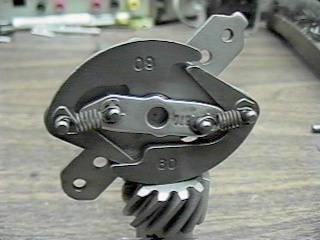
Then it was found that when
driving at low speeds with the throttle almost shut the reduced filling of the
cylinder caused the mixture to burn more slowly than at full throttle. So
an additional advance mechanism was invented that had a vacuum diaphram and
spring to advance the timing at high vacuum conditions when the throttle was
almost closed and the motor was running at much reduced power.
This combination served very
well to make the ignition function so smoothly and unobtrusively as to be
ignored until a failure from lack of maintenance occurred.
The weakest link in the chain
of reliability was the points. After that the spark
plugs.. The points were only capable of about 5-10 thousand
miles of operation before they needed adjustment or replacement.
The tiny spark every time they opened eventually destroyed them..
Consider that in 5000 miles on a v8 motor that is about fifty million nasty
little sparks eating away at the tungsten contacts..
As the points were
disintegrating it would cause the gap to widen and the dwell time to
increase. This would increase the current beyond what was needed to
generate the maximum magnetic field in the coil causing it to heat up and
reduce it’s output. Also with the larger gap the timing would
be retarded, sometimes enough to cause overheating in the summer..
Too little or too much gap both could cause problems.
Meanwhile in the motor the
spark plugs were losing metal from the sparking and the gap would widen and the
electrodes would be rounded both causing more voltage to be needed to fire the
mixture properly..
Then about 45 or 50 years
after Kettering’s invention (a long time for technology to stay the same) a
major improvement to his ignition system was made.
Others had similar devices
but I will discuss the GM HEI Ignition system. This concept brought
Kettering’s 19th century design into the 20th century.
The points were discarded and
replaced by a magnetic reluctor. This is a star shaped piece of
metal rotating within a circular magnetic pole with matching points directed
inward toward the center. See picture below for a view of the
reluctor and sensor pole in the HEI.
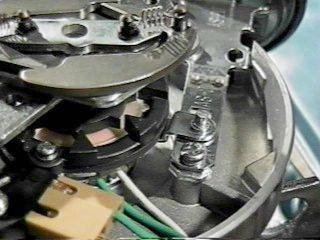
The change in magnetic flux in the reluctor/sensor assembly was detected by a winding at the base of the sensor and provided an input to the transistorized switching circuit in the ignition module. The output of the ignition module went to a coil similar to the Kettering design but GM chose to package the coil in the top of the distributor cap to make the ignition a one piece unit.
There was no need for
the capacitor to protect points but one was installed to prevent interference
to the car radio..
The reluctor/sensor/switch module arrangement took the place of the unreliable points and could go for hundreds of thousands of miles without problems.. A most impressive advance.
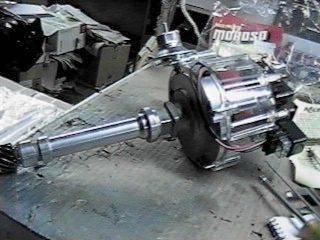
See picture above for a look at the complete integrated
system. And picture below shows a schematic of the HEI system.
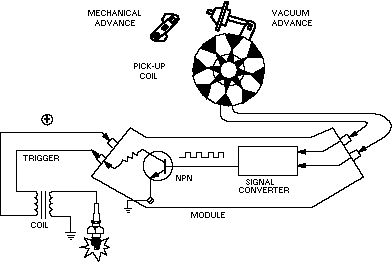
The voltage available from
the HEI is much greater than the old points style system. About 35-40
thousand volts compared to 20-25 thousand from the points
stystem. This allowed the sparkplugs to run a larger gap and be
less sensitive to wear and fouling. A superior system in every way except
one. If you are ever shocked by the high voltage from a HEI system you
will never forget it.
The GM HEI is a fine reliable
system for stock autos but.. (another one of them)
It does require some changes
to make it suitable for high performance use. Changes to make the
timing more precise, to make the advance curve provide maximum horsepower, and
to allow higher rpm operation.
These issues will be
addressed in my next article..
Rick Draganowski
Gold Beach, Oregon